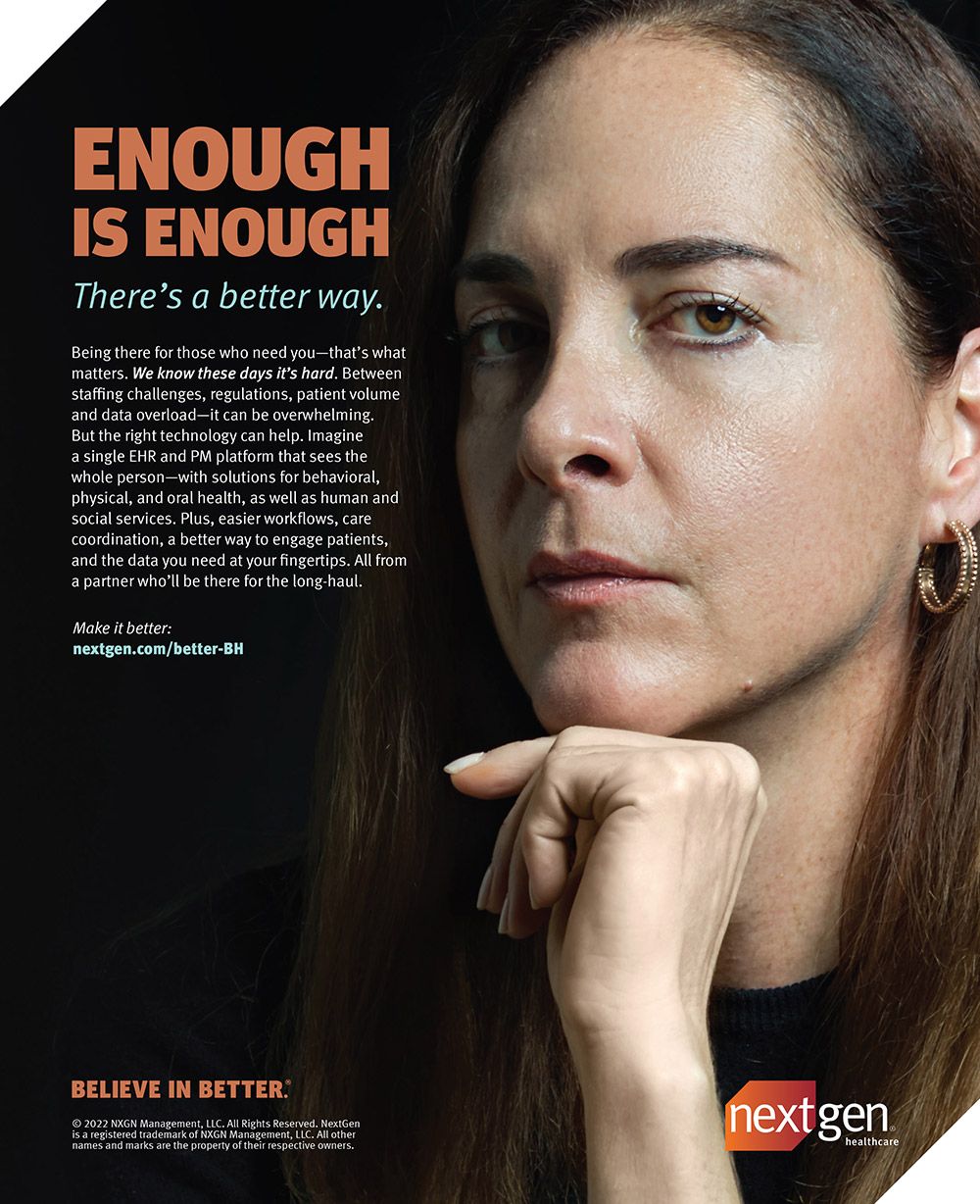“Out of all human events, it is tragedy alone that brings people out of their own petty desires and into awareness of other humans’ suffering. Tragedy occurs in human lives so that we will learn to reach out and comfort others.”
– C. S. Lewis
Throughout history, we have learned many of life’s most important lessons by pulling together in tragedy and the collective experiences that push us to the very limits of what we believe we can endure. The COVID-19 global pandemic pressed everyone – especially healthcare workers – to the brink of our physical, emotional, and mental well-being. For many of us, quarantine led to isolation and intense feelings of powerlessness, loneliness, and despair. No one was exempt. These experiences and emotions impacted adults and children alike, across all socioeconomic and demographic strata nationwide.

According to a Kaiser Family Foundation report, U.S. adults reporting symptoms of anxiety and depression increased from 11% to 41% during the pandemic.1 More than 48% of adults aged 25 to 49, the age range that most closely represents the majority of healthcare workers, reported symptoms of anxiety and depression during the pandemic. This increase in stress and mental health concerns occurred at a time when both mental health and addiction services were in exceptionally high demand, needed desperately by millions, placing an even great burden on a taxed system of care. Providers were burning out at unprecedented rates. Healthcare staffing shortages, initially due to physical illness and mental health concerns, as well as barriers to accessing services due to stay-at-home orders and other public health emergency-related restrictions, remain one of the most pressing challenges for behavioral health organizations nationally.
We have always struggled with behavioral health provider staff shortages in our country, and provider burnout has been a problem across all healthcare specialties and care providers. When the pressures of the pandemic added to these already taxed, limited, and relatively low-paid resources, even more providers chose to leave the field. As a result, access to mental health and addiction services rates have plummeted. According to the American Public Health Association, these provider and staff shortages impact an estimated 132 million Americans, with more than 6,600 mental health practitioners needed to fill vacancies.2
Even before the pandemic, a years-long contraction of services due to budget cuts and turnover were laying the foundation for this crisis. When it comes to addressing the complex issues associated with our behavioral health workforce shortages, no one can deny that burnout is a leading factor. The American Journal of Psychiatry reported in 2020 that 78% of psychiatrists surveyed self-reported burnout.3 There is a specific psychology to employee burnout. It can impact a person’s mental health and even lead to substance use. Employees are any company’s brand ambassadors, so keeping them healthy – and supporting them in staying both physically and mentally healthy – is mission critical. For healthcare workers, absences whether due to physical illness, burnout, or mental health concerns have a profound impact on healthcare services access.
Expanding and Strengthening the U.S. Behavioral Health Workforce
Congress has acted to address the behavioral health workforce shortage and has provided investments in the fiscal year 2022, including nearly $225 million for behavioral health professional and paraprofessional education.4 With more than one-third of Americans living in a designated Mental Health Professional Shortage area, President Biden in his State of the Union speech, on March 1, 2022, committed to investing $700 million in programs that provide education and training, scholarships, and loan repayment plans for clinicians committed to working in underserved communities.
In addition, the Centers for Disease Control and Prevention (CDC) is funding the Association of State and Territorial Health Officials (ASTHO) Public Health, Equity, Resilience, and Opportunity Program (PH-HERO), which aims to address workforce burnout, resiliency, and morale. The program is designed to create and support a culture of well-being and resilience within local, state, and territorial public health agencies to help reduce public health workforce mental health concerns, aid in hiring and retention efforts, and boost morale across the workforce.
According to ASTHO,5 the program is planned to include:
- Partnerships with national organizations, experts, and leaders in organizational change, leadership, and workforce development.
- Compiling models, approaches, and resources related to organizational wellness and resiliency, and assessing public health agency needs related to addressing burnout.
- Developing resources public health leaders can use to address worksite well-being, including assessment tools, training, and resource guides for workers, supervisors, and agency leaders.
- Pilot with up to five public agencies coaching and technical assistance to support the planning and implementation of an initiative to improve morale and burnout.
Behavioral health providers have several opportunities for intervention that can make an impact on both attracting talent and reducing burnout. The first is developing a culture of work/life balance, providing programs and tools for staff to support them in setting and respecting their work/life boundaries, fostering self-care, and consistently reinforcing that cultural norm. With continued access issues and staff shortages, it is tempting for administrators to keep piling unmanageable workloads on staff in the spirit of helping clients get access to critical services, but what unfortunately results is operating in “survival mode.” Operating in survival mode leads to the burnout that we must work to prevent.
The other area where we can support providers and staff is by investing in technology that makes their administrative and documentation burden lighter through efficiency and automation, as well as tools to ensure that the care they are providing is high quality. With public-funded Medicaid and Medicare, the massive amounts of documentation and compliance requirements for payment can be incredibly cumbersome. Fortunately, there is technology available that can reduce that burden substantially.
The combination of strategies that support team member well-being and work/life balance as well as adopting innovative technologies and automation to lessen the administrative burden on healthcare workers not only helps prevent burnout in existing team members but can also attract new talent. Demonstrating a culture that holds itself accountable to these ideals will go a long way to retain the best employees on your team.
Understanding the U.S. Behavioral Health Workforce
President Biden’s national mental strategy, as outlined in his 2022 State of the Union address, prioritizes strengthening system capacity to expand the supply and diversity of the behavioral health workforce. However, little is known about the current behavioral health workforce due to limited national data.
In March of 2022, the U.S. Department of Health and Human Services announced that the Substance Abuse and Mental Health Services Administration (SAMHSA) is supporting the development of a Behavioral Health Workforce Tracker, a new database of more than 1 million behavioral health providers.6
The George Washington University Fitzhugh Mullan Institute for Health Workforce Equity, with support from a 3-year grant from SAMHSA, developed a national database on the mental health and substance use disorder workforce. The database includes data on behavioral health physicians, psychologists, counselors, therapists, and advance practice providers. According to the Fitzhugh Mullan Institute for Health Workforce Equity, the goal of this database is to “provide evidence-based support for policy making and appropriate targeting of resources.” The Behavioral Health Workforce Tracker will allow users to visualize the availability of behavioral health providers by geography, provider type, and Medicaid acceptance status.
Ensuring the United States has an adequate supply of behavioral health providers has never been more important. Before the pandemic, the rate of unmet need for behavioral health and substance use disorder services was already rising. The COVID-19 pandemic exacerbated this need, particularly as it relates to the treatment and prevention of serious mental illness and substance use disorders. It is important that behavioral health provider organizations take a holistic approach to the ongoing well-being of their team members and employ technology solutions that reduce the administrative and documentation burden on providers and staff.
Javier Favela is VP, Solutions Behavioral Health & Integrated Care at NextGen Healthcare. For more information, please visit www.nextgen.com/1-bh.
Footnotes
- Nirmita Panchal, Rabah Kamal, Cynthia Cox, and Rachel Garfield, “The Implications of COVID-19 for Mental Health and Substance Use,” https://www.kff.org/coronavirus-covid-19/issue-brief/the-implications-of-covid-19-for-mental-health-and-substance-use/, Published: Feb 10, 2021
- Mark Barna, “Mental health workforce taxed during COVID-19 pandemic: Worker shortage hinders access,” https://www.thenationshealth.org/content/51/10/1.3, Published January 2022
- Richard F. Summers, M.D., Tristan Gorrindo, M.D., Seungyoung Hwang, M.S., M.S.E., Rashi Aggarwal, M.D., Constance Guille, M.D., “Well-Being, Burnout, and Depression Among North American Psychiatrists: The State of Our Profession,” https://ajp.psychiatryonline.org/doi/10.1176/appi.ajp.2020.19090901, Published Online 14 July 2020
- “Fact Sheet: Celebrating Mental Health Awareness Month 2022,” https://www.hhs.gov/about/news/2022/05/03/fact-sheet-celebrating-mental-health-awareness-month-2022.html, Published May 3, 2022
- “ASTHO Launches Resiliency Program to Support Public Health Workforce,” https://www.astho.org/communications/newsroom/2022/astho-launches-resiliency-program-to-support-public-health-workforce/, Published February 15, 2022
- “Fact Sheet: Celebrating Mental Health Awareness Month 2022,” https://www.hhs.gov/about/news/2022/05/03/fact-sheet-celebrating-mental-health-awareness-month-2022.html, Published May 3, 2022






